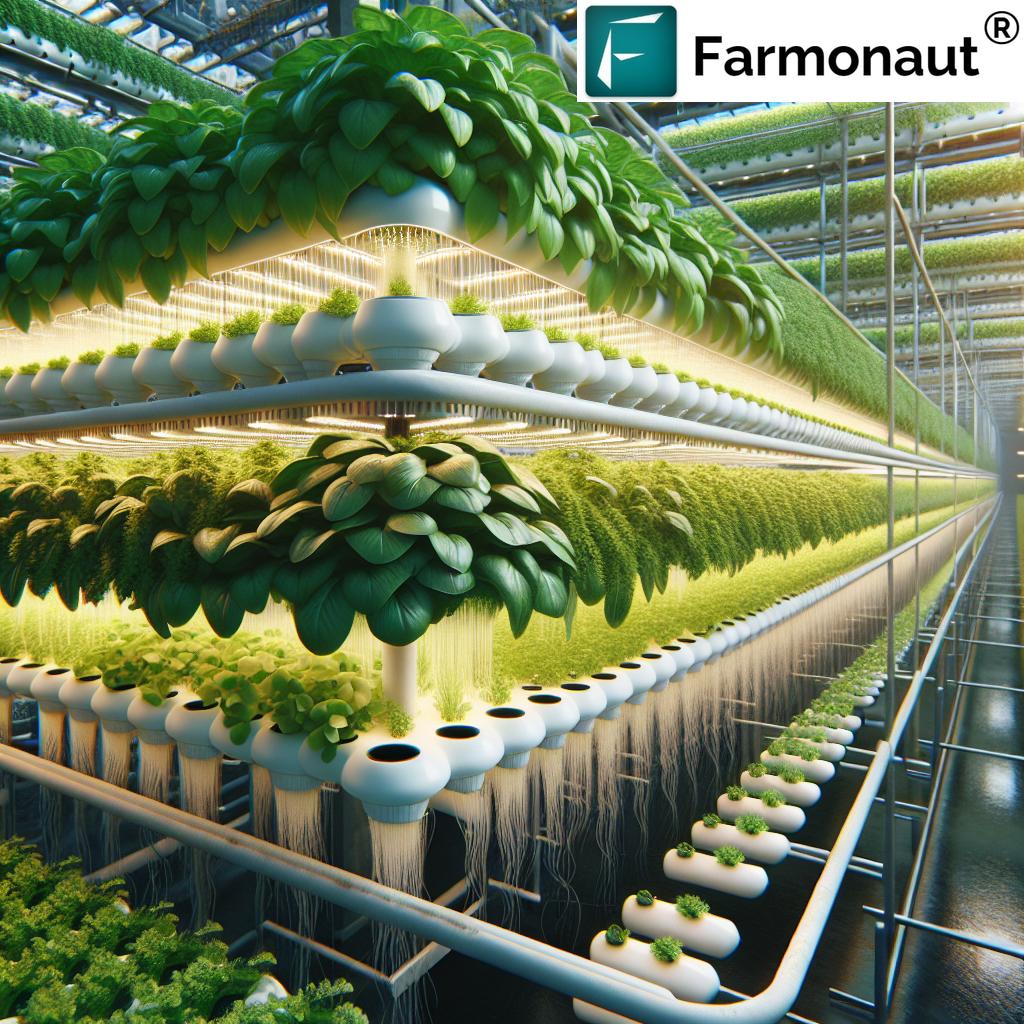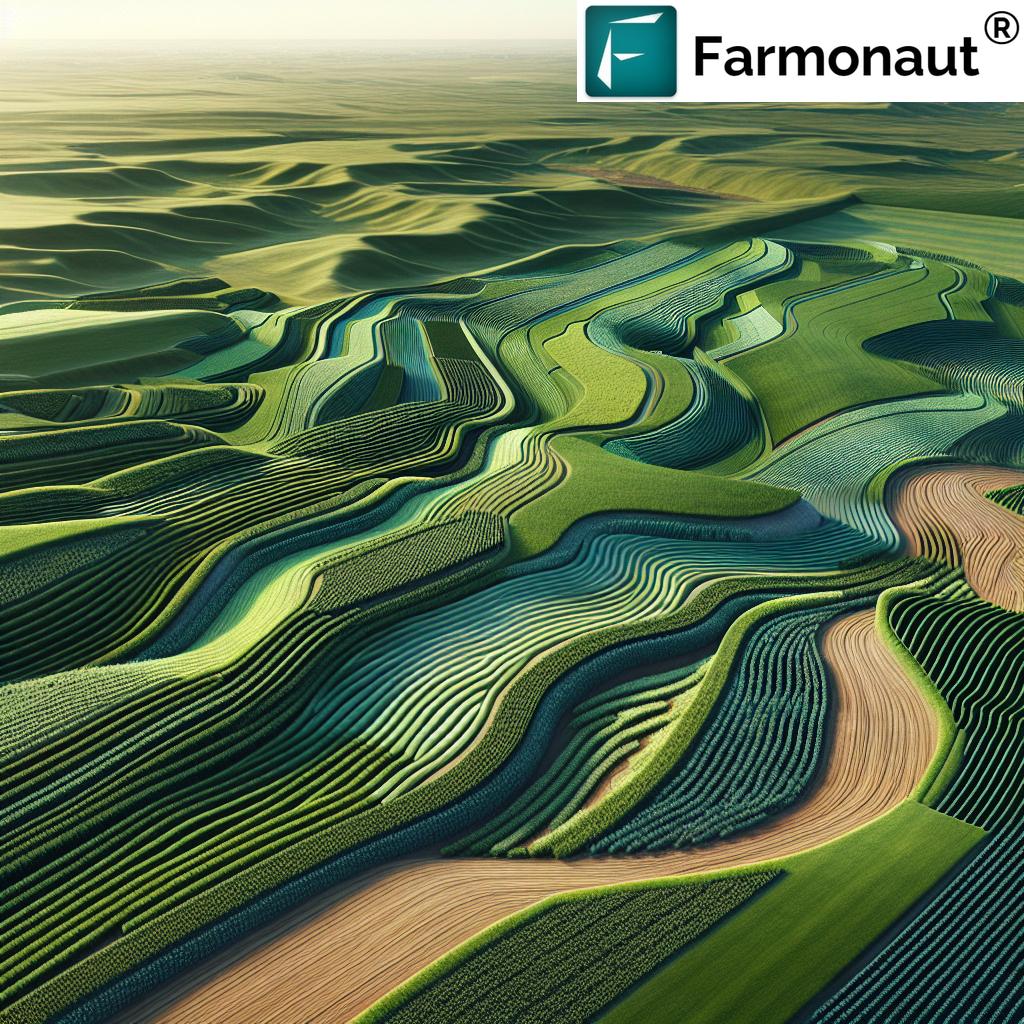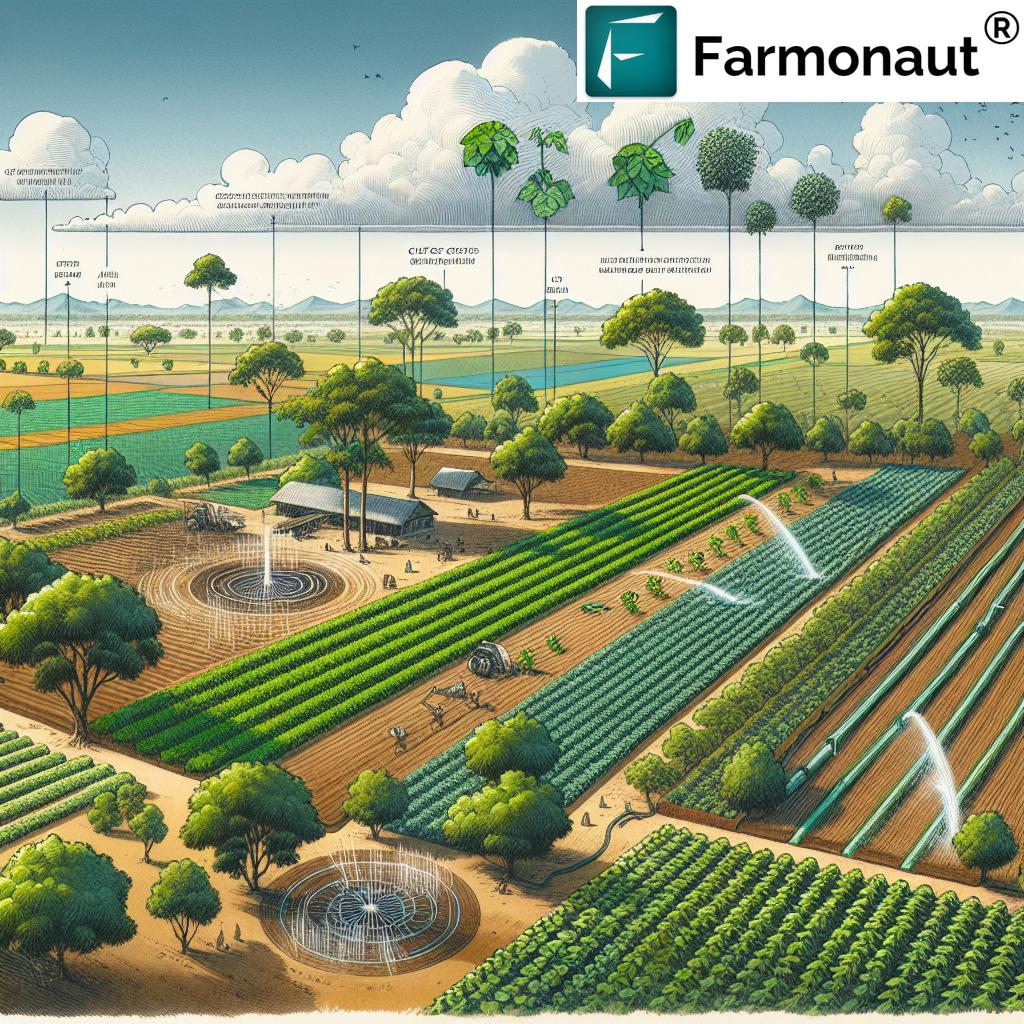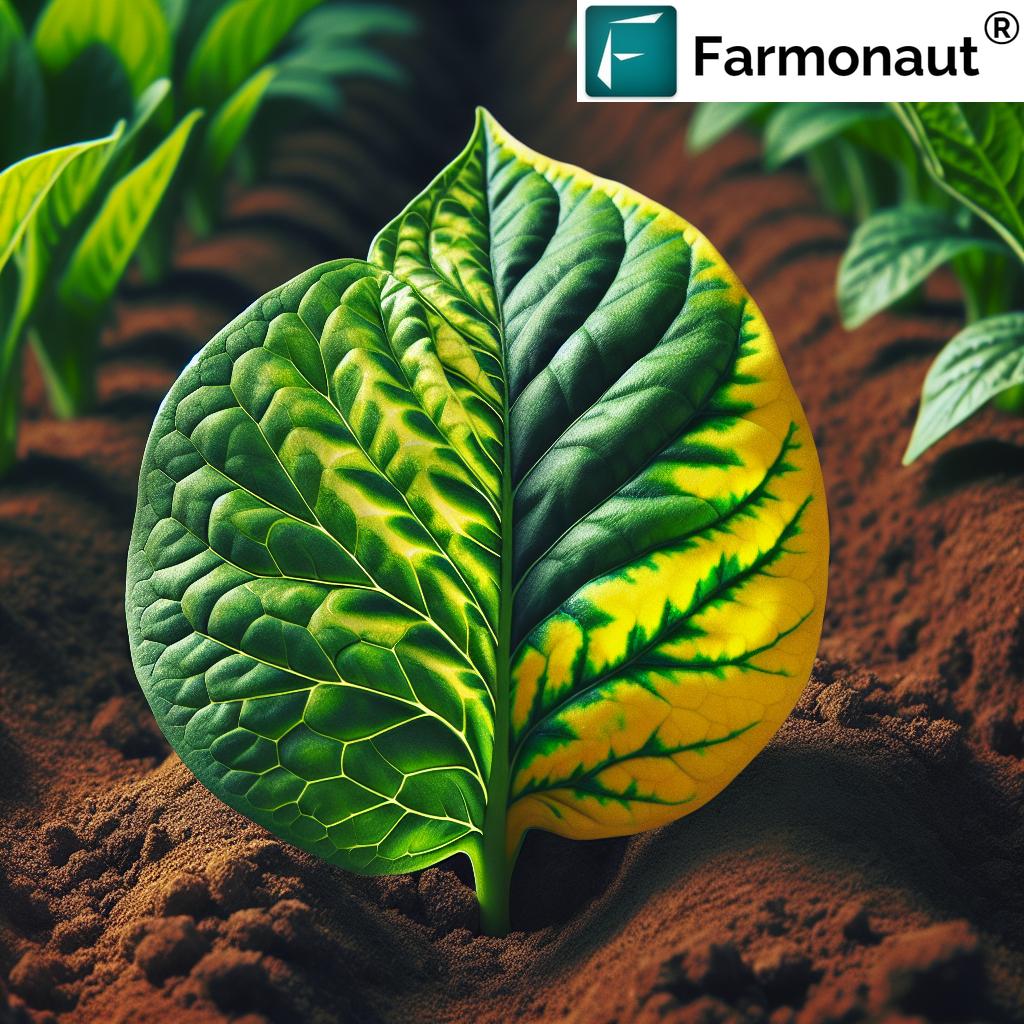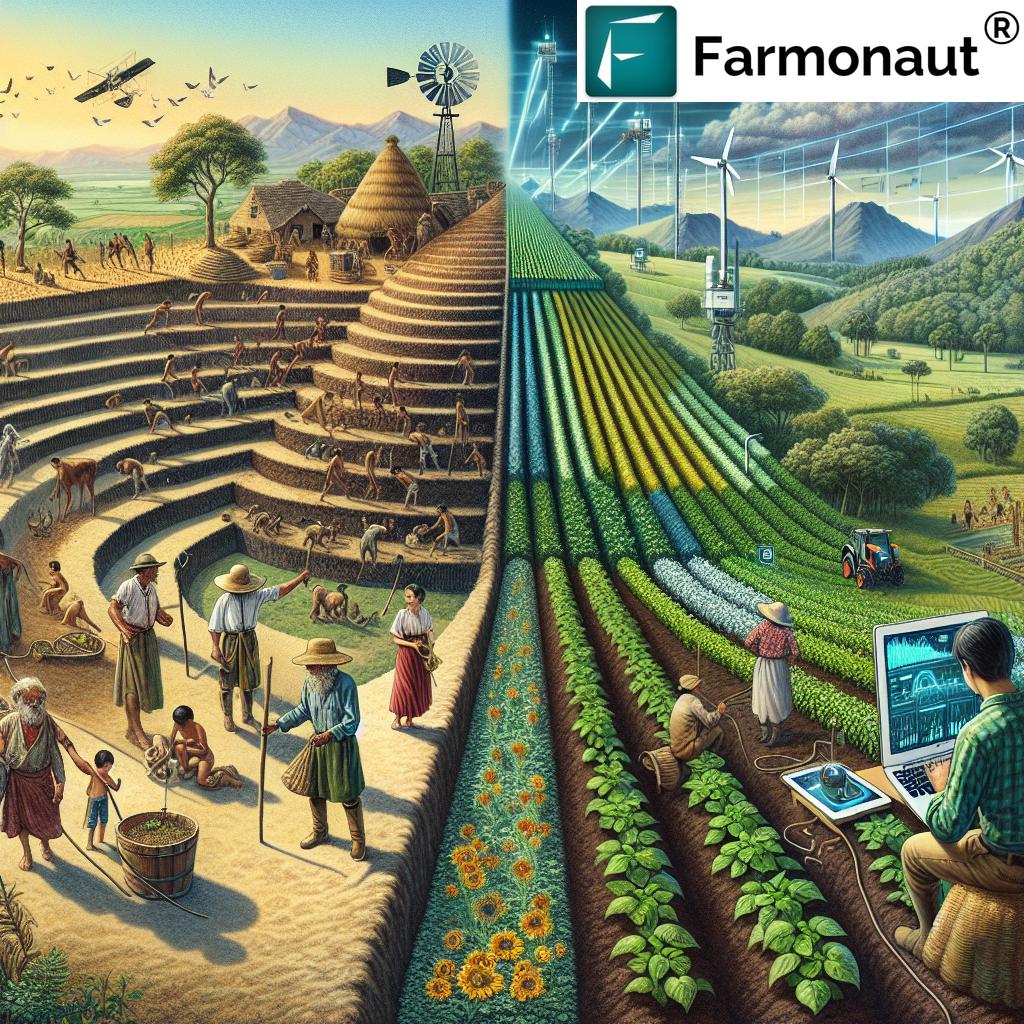Hydroponics Farming: 7 Shocking Innovations Revealed
“Hydroponic systems can use up to 90% less water than traditional soil farming methods.”
Table of Contents
- Introduction to Hydroponic Farming & Soilless Cultivation
- Historical Background: The Origin of Soilless Agriculture
- Hydroponic Systems: Exploring the Foundations
- Hydroponic Advantages & Resource Efficiency
- 7 Shocking Innovations in Hydroponic Farming
- Comparison Table of Hydroponic Innovations and Their Impact
- Farmonaut: Precision Agriculture for Hydroponics & Soilless Cultivation
- Challenges & Considerations in Hydroponic Systems
- Future Outlook: Technological Advancements & Urban Agriculture Solutions
- FAQ: Hydroponics, Innovation, and Advanced Farming
- Conclusion
Introduction to Hydroponic Farming & Soilless Cultivation
Hydroponic farming, an innovative soilless cultivation method, is rapidly transforming how we approach food production in the modern world. At its core, hydroponics is about growing plants without soil by providing nutrients directly through water solutions. As the global population surges and issues like arable land scarcity, water shortages, and resource pressure intensify, embracing hydroponic systems offers promising solutions for achieving sustainable food production and maximizing crop yields.
This blog aims to unveil “7 Shocking Innovations” that are redefining hydroponic farming—making it not only a sustainable alternative but a future-proof model for urban agriculture solutions. Alongside these innovations, we’ll discuss how companies like Farmonaut empower growers using advanced technological tools for precision management, resource efficiency, and data-driven optimization.
Historical Background: The Origin of Soilless Agriculture
The concept of growing plants without soil isn’t as recent as many believe. Our journey begins in the 17th century when Francis Bacon documented the first experiments with water-based plant growth in his work, “Sylva Sylvarum” (1627). By 1699, John Woodward advanced these studies by successfully cultivating spearmint in various water solutions, discovering—surprisingly—that less-pure water encouraged better growth than distilled water.
The pivotal moment for soilless cultivation arrived in the mid-1800s, when German botanists Julius von Sachs and Wilhelm Knop developed the foundations for what we now recognize as hydroponic techniques. Von Sachs famously proved that land plants could absorb nutrients dissolved in water, resulting in healthy plants that grew vigorously and bore seeds, without ever touching soil. These early scientific advances set the stage for today’s revolution in hydroponic farming and sustainable food production.
Hydroponic Systems: Exploring the Foundations
Modern hydroponic systems have evolved to maximize resource efficiency, optimize nutrient delivery, and create ideal growing conditions—often far superior to what traditional soil-based farming can provide. Let’s break down some of the most popular system types powering the hydroponic revolution:
- Deep Water Culture (DWC): In this system, plant roots are suspended directly in nutrient-rich, oxygenated water. DWC is widely used for leafy greens and herbs due to its simplicity and fast growth rates.
- Kratky Method: An ingenious passive technique requiring no electricity, pumps, or complex circulation systems. Plants are placed above a reservoir of nutrient-rich water, relying on natural evaporation and uptake—perfect for both commercial scale and home hydroponic gardening.
- Nutrient Film Technique (NFT): Plants rest in channels where a continuous flow of water delivers nutrients and is recycled efficiently. Known for excellent oxygenation and water savings, NFT is a top pick for urban vertical farming technology.
- Aeroponics: Roots are suspended in air and misted with a nutrient solution, achieving rapid crop growth and outstanding resource utilization—often used for high-value crops.
By understanding these methods, we can appreciate how tailored hydroponic systems lay the foundation for soilless cultivation breakthroughs and improved crop outcomes.
“Some hydroponic farms report crop yields up to 30% higher compared to conventional agriculture.”
Hydroponic Advantages & Resource Efficiency
Adopting hydroponic farming brings a host of advantages, especially as we pursue more sustainable food production models:
- Resource Efficiency: Hydroponic systems can slash water usage by up to 90% compared to traditional farming. By recycling nutrient solutions, growers eliminate much of the waste usually lost to runoff, delivering nutrients directly to plant roots with pinpoint accuracy.
- Year-Round Crop Production: With control over climate variables (temperature, humidity, light), hydroponics facilitate continuous production even in harsh, arid, or urban environments, making fresh produce available any season.
- Increased Crop Yields & Quality: Precise control of nutrient levels and environmental conditions turbocharges plant growth, achieving up to 20-30% higher yields with premium quality compared to conventional soil farming.
- Environmental Sustainability: Hydroponic methods reduce soil erosion, cut pesticide usage, and enable urban farming, which in turn decreases the carbon footprint associated with long-distance food transportation.
- Urban Agriculture Solutions: Growing crops in non-arable or densely populated urban spaces—on rooftops, warehouses, or containers—directly improves food security and local produce availability.
These strengths make hydroponic farming systems a cornerstone for future-ready, resilient agriculture.
7 Shocking Innovations in Hydroponic Farming
Let’s dive into the seven groundbreaking innovations that are driving the next era of hydroponic farming—delivering increased yields, unmatched efficiency, and a powerful boost to agricultural sustainability:
1. Deep Water Culture (DWC) – Oxygenated Root Zones
Deep Water Culture (DWC) has evolved as a high-performance method for hydroponics, especially suited for leafy greens and herbs. In this system, plant roots are suspended directly in a constantly oxygenated, nutrient-rich water solution. Air stones and diffusers deliver an abundance of dissolved oxygen, which prevents root diseases and allows crops to absorb nutrients efficiently, resulting in faster growth and higher yields.
- Estimated Yield Increase: 20-30% above soil farming
- Water Savings: Up to 85%
- Best For: Fast-turnover crops like lettuce, basil, and spinach
2. Kratky Method – Passive Hydroponics for Scaling
The Kratky Method stands out for its simplicity and cost-effectiveness. A pioneering passive system, it requires no pumps, no electricity, and minimal attention. Plants are placed above a closed reservoir, with roots dipping into the nutrient solution. As the plants absorb water, the level drops, exposing more roots to air—naturally delivering the perfect mix of water and oxygen.
- Estimated Yield Increase: 15-25%
- Water Savings: Up to 90%
- Best For: Home gardening, educational setups, leafy crops
3. Smart Sensor Integrated Hydroponics (IoT)
A major leap comes from the integration of smart sensors, AI, and IoT technology in hydroponic systems. These advanced platforms enable real-time monitoring and automatic control of pH, EC (electrical conductivity), temperature, humidity, and nutrient concentrations. Growers receive instant alerts and can automate their system for optimal crop growth without constant manual checks.
- Estimated Yield Increase: 25-35%
- Water Savings: 80-90%
- Best For: Precision commercial farming
4. Vertical Farming Technology
Vertical farming leverages the power of hydroponic methods to stack crops in multiple layers, optimizing the use of urban space while dramatically increasing production per square meter. High-density, climate-controlled facilities are used for commercial-scale farming in cities, reducing the transportation footprint and providing fresh produce directly to local consumers.
- Estimated Yield Increase: Up to 400% (per square meter)
- Water Savings: 80-95%
- Best For: Urban agriculture, food deserts, rooftop and warehouse farming
To monitor water consumption and reduce carbon footprint in such dense urban productions, satellite-based data from Farmonaut’s Carbon Footprinting tools help track environmental impact and drive sustainability goals.
5. Automated Nutrient Dosing Systems
New automated nutrient dosing systems use advanced sensors to regularly analyze nutrient and pH levels, delivering precisely what crops need at the right time. By cutting out human error and ensuring optimal solutions, these systems maximize resource efficiency and are essential for large commercial operations.
- Estimated Yield Increase: 15-25%
- Water Savings: 85-90%
- Best For: High-value crops, professional greenhouses
6. Blockchain-Based Traceability in Hydroponics
Blockchain is now being adopted for product traceability in hydroponic food supply chains, answering consumer demand for transparency. Every step—from plant to harvest to delivery—is recorded and accessible. This system is crucial for building trust and certifying the authenticity of sustainable hydroponic produce worldwide.
Learn more about Farmonaut’s blockchain-based Product Traceability platform. It enables verifiable food chain transparency, which is vital for brand reputation and consumer confidence.
- Estimated Yield Increase: Process-based; not yield-specific but ensures data-driven quality assurance
- Water Savings: Indirect by optimizing the supply chain
- Best For: Exporters, organic and high-value produce brands
7. Satellite & AI-Based Hydroponic Farm Monitoring
The fusion of satellite imagery and AI, as pioneered by Farmonaut, is now being used to monitor hydroponic (soilless) farms at scale. With real-time visibility into crop health, environmental conditions, and stress factors, growers can optimize resource use, detect anomalies promptly, and plan harvests with high precision.
Explore Farmonaut’s large-scale farm management app that supports satellite-based monitoring, tailored for high-tech hydroponic operations and modern urban agriculture solutions.
- Estimated Yield Increase: 10-20% through informed management
- Water Savings: 80-90% via precise irrigation planning
- Best For: Commercial multi-site operations, agribusinesses, and indoor growers
Comparison Table of Hydroponic Innovations and Their Impact
| Innovation Name | Description | Estimated Yield Increase (%) | Water Savings (%) | Resource Efficiency |
|---|---|---|---|---|
| Deep Water Culture (DWC) | Roots suspended in oxygenated, nutrient-rich water for rapid and healthy crop growth | 20–30% | 85% | Direct root absorption, minimal waste |
| Kratky Method | Passive, no pumps/electricity; plants suspended above water reservoir | 15–25% | 90% | Low infrastructure, perfect for soilless home setups |
| Smart Sensor (IoT) Hydroponics | Automated monitoring and control via sensors, AI, and IoT | 25–35% | 80–90% | Adjusts in real time, eliminates excess use |
| Vertical Farming Technology | Layered indoor/outdoor hydroponics for max yield per land unit | Up to 400% (per m²) | 80–95% | Optimizes urban space, reduces carbon footprint |
| Automated Nutrient Dosing | Precision delivery of nutrients and water by automated systems | 15–25% | 85–90% | Enhances consistency, reduces waste |
| Blockchain-Based Traceability | Tracks crop journey from seed to sale, increasing transparency | Process-based (quality assurance) | Indirect | Boosts supply chain trust, reduces losses |
| Satellite & AI Monitoring | Remote crop health & environmental monitoring for actionable insights | 10–20% | 80–90% | Early intervention, efficient farm management |
Farmonaut: Precision Agriculture for Hydroponics & Soilless Cultivation
While these innovations drive the future of hydroponic farming, their true potential unfolds with technology platforms designed to empower growers. Farmonaut is a pioneering agricultural technology company whose mission aligns perfectly with the needs of tech-forward hydroponic and urban agriculture solutions.
- Satellite-Based Crop Health Monitoring: Access real-time insights into vegetation health (NDVI), soil moisture, and field conditions for smarter irrigation, fertilizer application, and pest management—reducing input costs and maximizing yields.
- Jeevn AI Advisory System: Personalized, AI-driven advisory for optimizing crop schedules, anticipating weather disruptions, and decoding complex data into simple, actionable recommendations.
- Blockchain-Based Product Traceability: For urban food security, organic produce, and export markets alike, verifiable supply chain records boost transparency and trust.
- Fleet and Resource Management: Fleet management tools help large hydroponic operations oversee logistics, optimize fleet usage, and cut operational costs—essential for distributed and urban growers.
- Carbon Footprinting for Sustainable Agriculture: Track and reduce your environmental impact with real-time monitoring of greenhouse gas emissions—from energy usage to waste management—in your hydroponic system.
- Crop Loan & Insurance Validation: Satellite-based validation simplifies crop loan approvals for hydroponic and soilless growers, reducing fraud and improving access to much-needed financing.
Farmonaut’s solutions are accessible via Android, iOS, web apps, and API integrations for other agritech systems. Developers and research institutions looking for tailored data access can leverage the Farmonaut Satellite & Weather API (read the API documentation) for building advanced control and monitoring into their own hydroponic management platforms.
Whether you manage a vertical farming installation in a city, a large greenhouse, or a small home hydroponics project, Farmonaut’s smart tools are designed to help you optimize production, costs, and sustainability.
Challenges & Considerations in Hydroponic Systems
Despite the significant hydroponic advantages, transitioning to soilless cultivation carries certain challenges:
- Initial Setup Costs: Deploying advanced hydroponic systems requires upfront investment in infrastructure, climate control technology, and, for some, physical retrofitting of urban buildings.
- Technical Expertise: Understanding nutrient management, environmental control, and system maintenance is crucial. Training and digital guidance become vital, especially in large or commercial projects.
- Energy Consumption: Intensive lighting (LEDs, for instance) and environmental controls can elevate power use, partially offsetting water and resource savings if not carefully managed.
- System Failures: Unlike in soil, a pump or power failure in hydroponic farming can rapidly impact plant survival due to the lack of buffer provided by earth.
Addressing these barriers demands ongoing training, robust technology, and platforms for monitoring and early alerts—like those provided by Farmonaut—to realize the full potential of hydroponics.
Future Outlook: Technological Advancements & Urban Agriculture Solutions
The future for hydroponic farming is incredibly bright, powered by relentless research, innovation, and cross-disciplinary technology. Automation, AI-driven advisory, and environmental monitoring continue to lower operational costs and raise trust in hydroponics for leafy greens and other crops.
- IoT and Machine Learning: These technologies tailor nutrient and water management on a plant-by-plant basis, meaning even greater conservation and yield gains moving forward.
- Mass Urban Adoption: As vertical farming and hydroponic centers pop up in city centers across the globe, hyper-local food supply chains will reduce transportation, cut emissions, and bring permanence to urban food security.
- Sustainability Standards and Traceability: Increased demand for climate-accountable, transparent, and ethical food sources drives the growth of blockchain-backed traceability, like that offered by Farmonaut.
- Financial Access and Scalability: Satellite-driven verification for crop loan and insurance (read how Farmonaut makes it possible) helps more growers invest in hydroponic farming confidently, scaling their operations sustainably.
Latest projections estimate that worldwide investment in vertical farming technology and advanced hydroponics will reach almost $20 billion by 2026—a measure of trust in soilless cultivation as a mainstream solution for the coming decades.
FAQ: Hydroponics, Innovation, and Advanced Farming
-
Q: What is hydroponic farming, and how does it differ from traditional farming?
A: Hydroponic farming is a method of growing plants without soil, instead using nutrient-rich water solutions. Plants absorb nutrients directly through their roots, increasing efficiency, saving water, and allowing for cultivation in non-arable and urban locations. Traditional farming relies on soil, which can be less resource-efficient and more vulnerable to climate or land-related limitations. -
Q: Which crops are best suited for hydroponic systems?
A: Leafy greens (like lettuce, spinach, kale), herbs (basil, mint), cucumbers, tomatoes, peppers, and strawberries thrive in hydroponic systems due to their fast growth cycles and high market demand. -
Q: What are some advantages of hydroponic farming for urban agriculture solutions?
A: Hydroponic methods enable efficient use of city spaces, dramatically reduce the carbon footprint of food transportation, support year round crop production, and can boost food security in dense urban settings. -
Q: How is sustainability achieved in advanced hydroponic systems?
A: By recycling water, employing smart sensors for resource optimization, and integrating renewable energy and supply chain transparency through blockchain, hydroponic systems minimize environmental impact and enhance long-term sustainability. -
Q: What role does technology like Farmonaut play in hydroponic cultivation?
A: Farmonaut delivers precision agriculture tools, satellite-based crop monitoring, AI advice, blockchain traceability, and resource management—empowering growers to maximize productivity, reduce waste, and maintain sustainability in their hydroponic operations. -
Q: Is hydroponic farming expensive to start?
A: While setup costs can be significant, especially for commercial or large urban systems, innovations such as the Kratky method, and access to digital planning tools like Farmonaut, help lower barriers and bring cost-effectiveness to different scales of hydroponic farming. -
Q: Where can I find more information or manage my hydroponic farm digitally?
A: Check out Farmonaut’s Web, Android, and iOS apps for satellite, AI, and blockchain-powered farming assistance. See also the Farmonaut API and the Carbon Footprinting tools for environmental impact tracking.
Conclusion
Hydroponic farming is ushering in a new age of soilless cultivation solutions, meeting the world’s critical food, water, and sustainability challenges head-on. With innovations spanning from the simplicity of the Kratky method to AI-fueled farm management and urban vertical farming, growers now possess the tools and technology to maximize quality, consistency, and resilience in food production.
As research advances and platforms like Farmonaut bridge the gap between data and field, the dream of universally accessible, sustainable food production is coming within reach. The journey has just begun, and the possibilities—for our crops, our cities, and our planet—are limitless.
Ready to revolutionize your hydroponic or soilless venture?
Together, let’s build the future of efficient, smart, and sustainable agriculture—one innovation at a time.




